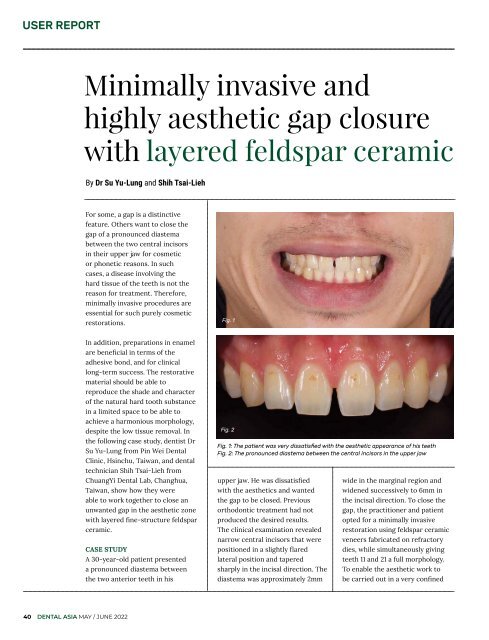Dental Asia May/June 2022
For more than two decades, Dental Asia is the premium journal in linking dental innovators and manufacturers to its rightful audience. We devote ourselves in showcasing the latest dental technology and share evidence-based clinical philosophies to serve as an educational platform to dental professionals. Our combined portfolio of print and digital media also allows us to reach a wider market and secure our position as the leading dental media in the Asia Pacific region while facilitating global interactions among our readers.
For more than two decades, Dental Asia is the premium journal in linking dental innovators and manufacturers to its rightful audience. We devote ourselves in showcasing the latest dental technology and share evidence-based clinical philosophies to serve as an educational platform to dental professionals. Our combined portfolio of print and digital media also allows us to reach a wider market and secure our position as the leading dental media in the Asia Pacific region while facilitating global interactions among our readers.
Create successful ePaper yourself
Turn your PDF publications into a flip-book with our unique Google optimized e-Paper software.
USER REPORT<br />
Minimally invasive and<br />
highly aesthetic gap closure<br />
with layered feldspar ceramic<br />
By Dr Su Yu-Lung and Shih Tsai-Lieh<br />
For some, a gap is a distinctive<br />
feature. Others want to close the<br />
gap of a pronounced diastema<br />
between the two central incisors<br />
in their upper jaw for cosmetic<br />
or phonetic reasons. In such<br />
cases, a disease involving the<br />
hard tissue of the teeth is not the<br />
reason for treatment. Therefore,<br />
minimally invasive procedures are<br />
essential for such purely cosmetic<br />
restorations.<br />
Fig. 1<br />
In addition, preparations in enamel<br />
are beneficial in terms of the<br />
adhesive bond, and for clinical<br />
long-term success. The restorative<br />
material should be able to<br />
reproduce the shade and character<br />
of the natural hard tooth substance<br />
in a limited space to be able to<br />
achieve a harmonious morphology,<br />
despite the low tissue removal. In<br />
the following case study, dentist Dr<br />
Su Yu-Lung from Pin Wei <strong>Dental</strong><br />
Clinic, Hsinchu, Taiwan, and dental<br />
technician Shih Tsai-Lieh from<br />
ChuangYi <strong>Dental</strong> Lab, Changhua,<br />
Taiwan, show how they were<br />
able to work together to close an<br />
unwanted gap in the aesthetic zone<br />
with layered fine-structure feldspar<br />
ceramic.<br />
CASE STUDY<br />
A 30-year-old patient presented<br />
a pronounced diastema between<br />
the two anterior teeth in his<br />
Fig. 2<br />
Fig. 1: The patient was very dissatisfied with the aesthetic appearance of his teeth<br />
Fig. 2: The pronounced diastema between the central incisors in the upper jaw<br />
upper jaw. He was dissatisfied<br />
with the aesthetics and wanted<br />
the gap to be closed. Previous<br />
orthodontic treatment had not<br />
produced the desired results.<br />
The clinical examination revealed<br />
narrow central incisors that were<br />
positioned in a slightly flared<br />
lateral position and tapered<br />
sharply in the incisal direction. The<br />
diastema was approximately 2mm<br />
wide in the marginal region and<br />
widened successively to 6mm in<br />
the incisal direction. To close the<br />
gap, the practitioner and patient<br />
opted for a minimally invasive<br />
restoration using feldspar ceramic<br />
veneers fabricated on refractory<br />
dies, while simultaneously giving<br />
teeth 11 and 21 a full morphology.<br />
To enable the aesthetic work to<br />
be carried out in a very confined<br />
40 DENTAL ASIA MAY / JUNE <strong>2022</strong>


















